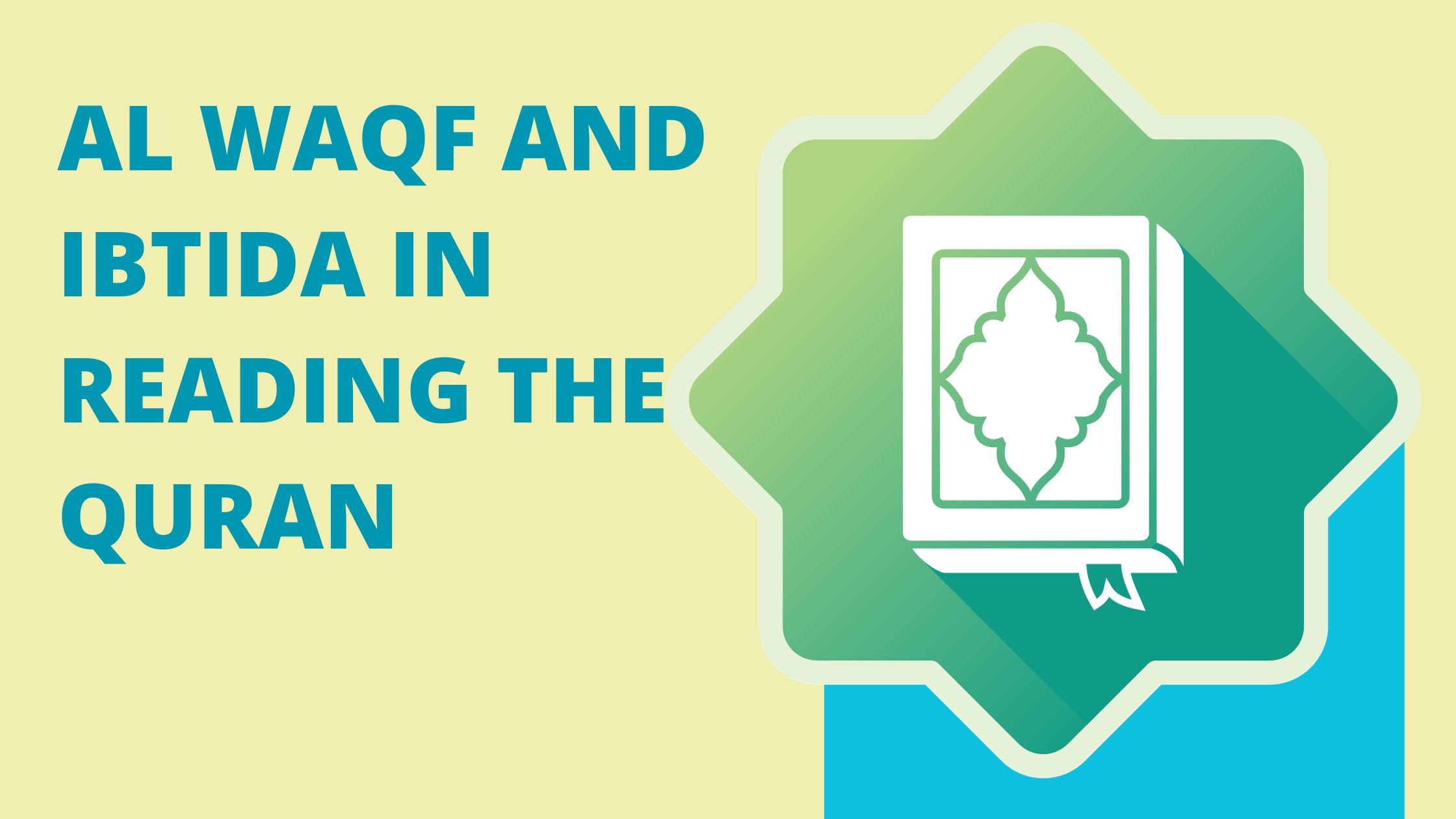In this blog post, we will explore the meanings of Al Waqf and Ibtida, their different types, the rules to follow when encountering them, and how to decipher the symbols used to represent them.
Join us as we uncover the hidden depths of the Quran and delve into the intriguing world of Al Waqf and Ibtida. For those seeking a deeper understanding of this sacred text, these two concepts are crucial in ensuring precise interpretation and pronunciation.
Table of Contents
The Definition of Stopping (Waqf)
The term “waqf” refers to the act of stopping or pausing while reciting the Quran. It involves cutting off the sound at the end of a word, usually for the duration of a breath, with the intention of continuing the recitation.
The purpose of waqf is not to finish the recitation but rather to indicate a temporary pause so that the reader can take a breath and then resume.
Understanding the rules and signs of waqf is essential for comprehending the meaning and structure of recited verses, as they indicate when to pause based on linguistic factors.
Types of Waqf (Stopping) in the Quran
Understanding and correctly applying the rules of waqf is crucial for reciters as it improves their recitation and comprehension of the Quran. The following are different types of waqf that contribute to the eloquence of Quran recitation:
1. The Optional Waqf:
This type of stop is chosen by the reciter voluntarily, without any external reasons. It allows the reciter to pause at specific points in the Quranic text for emphasis or to enhance the understanding of the verses.
The reciter has the freedom to decide where to make these optional stops, based on their own interpretation and desired effect.
2. The Compelled Waqf:
This type of stopping occurs when the reciter is compelled to pause due to external factors such as shortness of breath, sneezing, coughing, or any other physical limitations.
In such cases, the reciter can stop at the end of the word they were at, even if the meaning is not complete.
Once the compelling situation passes, the reciter resumes from the word they stopped on, continuing with the following words.
3. The Test Waqf:
This type of stop is commonly used during examinations or when being taught by a teacher. The teacher may interrupt the reciter and correct any mistakes or errors in pronunciation, Tajweed, or other aspects of recitation.
The reciter stops when instructed by the teacher and attempts to rectify the mistake pointed out before continuing with the recitation.
The Rules of Optional Waqf in the Quran
The Optional Waqf is a set of rules that assist reciters in pausing and continuing their recitation of the Quran in a proper and effective manner. It is important to familiarize oneself with these rules in order to enhance understanding of the Quran:
1. Hated Stop:
It is not allowed to stop on a word in the Quran when what comes after it is linked by both meaning and grammar.
This type of stop gives an incomplete or rejected meaning. If such a stop occurs, the reciter should go back and repeat without stopping.
An example of this is stopping on the word “ٱلْحَمْدُ” in the verse “ٱلْحَمْدُ لِلَّهِ رَبِّ ٱلْعَـٰلَمِينَ” (Al-Fatiha, 1:2).
2. Permissible Stop:
It is permissible to stop on a word in the Quran when what comes after it is linked by meaning and grammar, and stopping here still gives a complete meaning.
For example, you can stop on the word “اللَّـهِ” (Allah) in the phrase “بِسْمِ اللَّـهِ” (In the name of Allah), and then continue with “الرَّحْمَـٰنِ الرَّحِيمِ” (the Most Gracious, the Most Merciful).
3. Sufficient Stop:
It is allowed to stop on a word in the Quran when what comes after it is linked by meaning but not by grammar.
Here, the reciter has the option to either stop or continue. This type of stop is common at the end of verses and in between the ayahs.
An example of this is stopping at “فِي قُلُوبِهِم مَّرَضٌ فَزَادَهُمُ اللَّهُ مَرَضًا ۖ” in Surah Al-Baqarah (2:10) and then continuing with “وَلَهُمْ عَذَابٌ أَلِيمٌ بِمَا كَانُوا يَكْذِبُونَ” (and for them is a painful punishment because they used to lie).
4. Complete Stop:
It is permissible to stop on a word in the Quran when there is no link, either in terms of meaning or grammar, after it. The reciter stops briefly and then continues. This type of stop is common at the end of surahs, ayat, and stories.
For example, stopping at “أُولَٰئِكَ عَلَىٰ هُدًى مِّن رَّبِّهِمْ ۖ” in Surah Al-Baqarah (2:5) and then starting with “إِنَّ الَّذِينَ كَفَرُوا سَوَاءٌ عَلَيْهِمْ أَأَنذَرْتَهُم أَمْ لَمْ تُنذِرْهُمْ لَا يُؤْمِنُونَ” (Indeed, those who disbelieve – it is all the same for them whether you warn them or do not warn them – they will not believe).
At Bayan Al-Quran, we offer online Quran and Tajweed classes for kids to help them learn the proper recitation of the Quran. Enroll your child in our Quran and Tajweed program today and allow them to establish a strong bond with the Quran while mastering its beautiful recitation.
The Symbols of Waqf (Stopping) in Reading the Quran
The symbols of Waqf (stopping) play a crucial role in enhancing our understanding of the Quran. These symbols indicate where to pause or stop while reciting, which helps us grasp the meaning and context of the verses more effectively. Here are some important points to note about these symbols:
1. The symbol “مـ”
The symbol “مـ” indicates a compulsory stop to avoid altering the meaning of the verse.
2. The symbol “ط”
The symbol “ط” signifies a normal stop at the end of a sentence or thought.
3. The symbol “ج”
The symbol “ج” denotes a permissible stop, indicating that it is sufficient to pause at this point.
4. The symbol “صلي”
The symbol “صلي” or “ز” represents a permissible stop but preferable to continue, suggesting that it is better to keep reading without pausing.
5. The symbol “قلي”
The symbol “قلي” suggests that it is permissible to continue reading, but it is preferable to stop. It can indicate either a complete or sufficient stop.
6. The symbol “لا”
The symbol “لا” indicates that it is either not recommended to cut off the recitation or not to stop on the marked word and instead start on the following word.
7. – The symbol “قف”
The symbol “قف” is the Anticipation Mark, suggesting that it is preferable to stop at this point.
8. The symbol “∴”
The symbol “∴” appears twice on two words in an Ayah, it means that if you choose to stop on one of them, you are not allowed to stop on the other. However, it is also permissible to continue without stopping on either of them.
The Importance of Stopping Rules (Waqf) in Reading the Quran
The rules of stopping (Waqf) in reading the Quran are of utmost importance in maintaining the proper pronunciation, rhythm, and understanding of the Quranic text. Here are some key points highlighting the importance of these stopping rules:
1. Enhancing Comprehension and Context:
Stopping at appropriate places clarifies meaning and context, ensuring accurate comprehension.
2. Maintaining Recitation Flow and Rhythm:
Helps maintain correct recitation flow and rhythm, enhancing the beauty and melody of the Quranic recitation.
3. Promoting Reflection and Connection:
Proper stops allow for reflection and contemplation on verses, promoting a deeper connection with the message of the Quran.
4. Preservation of Intended Message:
Following stopping rules ensures that the intended message of the verse is preserved and not altered due to incorrect pauses or breaks.
5. Aid in Memorization:
Stopping rules aids in memorization as they provide natural breaks in the text, making it easier to remember the verses.
6. Understanding Linguistic Nuances:
These rules help distinguish between different grammatical structures and sentence constructions, enabling a more accurate understanding of the Quran’s linguistic nuances.
7. Structured and Organized Recitation:
Following Waqf signs allows for a structured and organized recitation, ensuring that the Quran is read in the correct order and sequence.
8. Showing Respect and Reverence:
By adhering to the stopping rules, readers show respect and honor to the Quran, treating it with the reverence it deserves.
Starting (Ibtida) Rules in Quran Reading
It is important to understand the rules of Ibtida for reading the Quran, as they help us approach each verse with clarity and respect. These rules are divided into two types: permissible and hated:
1. Permissible Ibtida
This type of starting occurs when a reciter begins reciting after completely stopping. It is allowed to start at the beginning of an ayah, surah, or even in the middle of an ayah without changing the meaning.
An example of this would be starting at the beginning of Surat As-Safaat ayah 138, after stopping on the previous ayah “And indeed, you pass by them in the morning.” In this case, the two ayat are grammatically and semantically connected.
2. Hated Ibtida
On the other hand, hated ibtida refers to starting the recitation in a way that changes the intended meaning of the ayah. This occurs when a reciter begins with a word or phrase that leads to a different meaning than what Allah desires, or a meaning that contradicts our beliefs.
For instance, starting with “Allah has taken a son” (Astaghfirullah) without first mentioning “They say” (وَقَالُوا). This form of starting is disliked because it alters the intended message of the verse.
If you want to learn more about the rules of Tajweed and improve your recitation of the Quran, please refer to our comprehensive guide at Bayan Al-Quran.
Discover the Beauty of Waqf and Ibtida While Reading the Quran: Enroll Your Kids in our Online Noorani Qaida Course at Bayan Al-Quran
At Bayan Al-Quran, we offer an online Noorani Qaida course for kids. Our program is designed to teach children the fundamentals of Quranic Arabic.
With the assistance of our exceptional supervisors and tutors from al-Azhar, your child can learn at their own pace and convenience.
Noorani Qaida is a book that teaches children crucial skills in reading the Quran, with a comprehensive curriculum of 17 chapters covering everything from the alphabet to Tajweed rules.
Join us today and give your child the chance to learn Noorani Qaida online and read the Quran fluently and eloquently.
Conclusion
It is important to understand the rules of waqf and ibtida when reciting the Quran in order to have a meaningful and impactful recitation.
Proper waqf can improve comprehension, flow, reflection, preservation of message, memorization, understanding of nuances, and structured recitation. Symbols can serve as visual cues for waqf and ibtida rules can help with beginning recitation correctly.
Enrolling children in an online Noorani Qaida course for kids at Bayan Al-Quran can help them appreciate the beauty of reading the Quran from a young age.

















